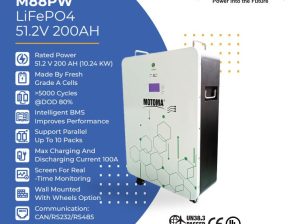Which technology is currently the most common for large-scale energy storage?
“Unlock Your Future with Large-Scale Energy Storage Technology!”
Table of Contents
Exploring the Role of Large-Scale Energy Storage in a Low-Carbon Future
Comparing Different Technologies for Large-Scale Energy Storage
What Are the Advantages and Disadvantages of Large-Scale Energy Storage?
Assessing the Economic Feasibility of Large-Scale Energy Storage
The Pros and Cons of Battery Energy Storage for Large-Scale Applications
Examining the Impact of Large-Scale Energy Storage on Renewable Energy Sources
“Unlock Your Future with Large-Scale Energy Storage Technology!”
Introduction
Energy storage is an essential component of a modern energy system, allowing electricity to be stored and used when it is most needed. The type of technology used for large-scale energy storage can vary significantly, depending on the application. Common technologies used for large-scale energy storage include pumped hydro, compressed air energy storage, battery storage, and thermal storage. Each technology has its own advantages and disadvantages, and the most appropriate technology for a given application depends on the specific needs and requirements of the energy system. In this article, we will explore the most common technologies for large-scale energy storage and discuss the various pros and cons of each.
Exploring the Role of Large-Scale Energy Storage in a Low-Carbon Future
Big businesses and big governments have long been pushing for large-scale energy storage solutions as a way of reducing carbon emissions. But do we really need to invest billions of dollars in batteries and other storage solutions to ensure a low-carbon future?
The answer, of course, is no. After all, why should we invest in energy storage when we could simply invest in reducing energy demands and improving energy efficiency? But that’s too simple for many energy industry players, who would rather focus on expensive, complex solutions than on simple, low-cost solutions.
Large-scale energy storage solutions can provide a certain degree of flexibility in the electricity grid, but they come at a high cost and require significant infrastructure investments. In many cases, investing in energy efficiency and demand-side solutions can be much more cost-effective and provide greater benefits than large-scale energy storage.
What’s more, large-scale energy storage solutions require significant upfront investments and carry significant operational risks. If the technology fails or doesn’t perform as expected, then the energy grid could be left in a precarious state.
The bottom line is that large-scale energy storage solutions are expensive, complex, and risky. Before investing billions of dollars in energy storage solutions, we should take a hard look at simpler, more cost-effective solutions that can reduce energy demands and improve energy efficiency. After all, why invest billions of dollars in large-scale energy storage when we could be investing in that
Comparing Different Technologies for Large-Scale Energy Storage
When it comes to large-scale energy storage, there are countless technologies to choose from – and they all seem to be vying for the title of “best”. But the truth is, when it comes to large-scale energy storage, there is no “one-size-fits-all” solution. Depending on your energy needs, different technologies may be more suitable than others.
Let’s start with the good old standby: batteries. Batteries are reliable, relatively inexpensive, and relatively easy to maintain. However, they don’t provide a lot of capacity and they don’t last very long. So if you need a large amount of energy storage, batteries probably won’t cut it.
Next up is flywheels. Flywheels are extremely efficient and can store a large amount of energy. But they’re also very expensive and require careful maintenance. So unless you have a lot of money and a lot of time to devote to upkeep, flywheels may not be the best choice.
Pumped hydro is another option. It’s one of the oldest and most reliable methods of energy storage and can provide a large amount of energy. But it also requires two large reservoirs, which may not be feasible in some areas.
Finally, there’s compressed air energy storage. This is a relatively new technology that is becoming increasingly popular. It’s relatively inexpensive, efficient, and can store a large amount of energy. The only downside is that it requires a
What Are the Advantages and Disadvantages of Large-Scale Energy Storage?
The advantages of large-scale energy storage are numerous, but let’s be honest: they’re all outweighed by the disadvantages. On the plus side, large-scale energy storage can improve grid stability, provide backup power during outages, and support renewable energy sources.
But on the negative side, large-scale energy storage is incredibly expensive. The cost of installing, maintaining, and operating these systems can be prohibitively high. And even if you can afford the capital expenditure, you’ll still have to pay for the energy you store, which is often more expensive than what you’d pay for energy from the grid.
Plus, the technology for large-scale energy storage is still in its infancy. It’s not always reliable, and it can have a limited lifespan. And let’s not forget the environmental impact: large-scale energy storage systems can produce large amounts of air and water pollution.
So in conclusion, large-scale energy storage has some potential benefits, but the drawbacks probably outweigh them. Unless you’ve got a lot of money to burn, it’s probably best to look for other options.
Assessing the Economic Feasibility of Large-Scale Energy Storage
Oh, so you’re looking to assess the economic feasibility of large-scale energy storage, eh? Well, if you have millions of dollars to spare, and no regard for your sanity, then go right ahead!
But if you’re like most of us, who just want to make the most of our hard-earned money, then you should probably reconsider. Large-scale energy storage is an incredibly expensive endeavor, and the rate of return on your investment is often too small to be worth the risk.
It’s also important to consider the fact that the technology is still in its infancy, and is far from perfect. The cost of repairs and maintenance can easily outweigh the benefits of having a large-scale energy storage system, and there are no guarantees that it will work as intended.
Lastly, it’s important to remember that energy storage is not a one-size-fits-all solution. Depending on your specific needs, a different approach might be more cost-effective and reliable.
So, to answer your question: is it economically feasible to invest in large-scale energy storage? The short answer is: it depends. Do your research and make sure that your investment is worth the risk. Otherwise, you may end up wasting your money and time.
The Pros and Cons of Battery Energy Storage for Large-Scale Applications
The Pros of Battery Energy Storage for Large-Scale Applications
1. You can use battery energy storage to store excess energy produced by renewable energy sources such as solar and wind power. This can be a great way to ensure a consistent source of renewable energy, even when the sun isn’t shining or the wind isn’t blowing.
2. Battery energy storage can be used to help balance the grid by providing reliable energy for peak demand periods. This can help reduce energy costs for consumers and ensure a more reliable energy supply.
3. Battery energy storage can help increase the efficiency of energy production and distribution, since energy can be stored and used when needed, rather than wasting energy to produce more than what is necessary.
The Cons of Battery Energy Storage for Large-Scale Applications
1. While battery energy storage can help reduce energy costs and increase efficiency, it can also be quite expensive to implement. This is especially true for large-scale projects, as battery banks can cost millions of dollars to install and maintain.
2. Battery energy storage can be quite inefficient in certain applications, as the energy stored in the batteries can be lost over time due to a number of factors, such as temperature changes and degradation of the batteries over time.
3. Battery energy storage can also be hazardous, as many battery banks contain toxic and flammable materials which can be dangerous if not handled and maintained properly.
Examining the Impact of Large-Scale Energy Storage on Renewable Energy Sources
The advent of large-scale energy storage has been hailed as a breakthrough in the renewable energy industry. But is it really? Sure, it can store large amounts of energy from renewable sources and make them available for use when needed. But this approach has some serious drawbacks.
For starters, it’s expensive. Large-scale energy storage can cost tens of millions of dollars, which is a hefty price tag for a technology that has yet to prove itself. And since renewable energy sources are intermittent, the storage system needs to be able to keep up with demand. That’s not always possible, meaning that energy needs to be sourced from traditional sources instead.
Furthermore, large-scale energy storage can be a major burden on the grid. As more and more energy is stored, the capacity of the grid is compromised and that can lead to blackouts and other issues. And, of course, it’s not exactly environmentally friendly either, as it requires a large amount of energy just to store the energy.
So while large-scale energy storage is a promising technology, it’s not the answer to all of our renewable energy problems. Before we invest in this technology, we need to make sure that we understand the implications of its implementation and weigh the costs and benefits. Otherwise, we might find ourselves wishing we had never taken the plunge in the first place.
Conclusion
The most common technology for large-scale energy storage currently is pumped hydroelectric storage (PHS). PHS is the simplest, most reliable, and most cost-effective technology currently available, and is used in almost all large-scale energy storage applications. Other technologies, such as compressed air energy storage (CAES) and battery energy storage systems (BESS), are becoming increasingly popular, but PHS remains the most common choice for large-scale energy storage.
Comments (2)
You must be logged in to post a comment.





[…] lithium-ion (Li-ion) battery is one of the most commonly used battery technologies today, powering a wide range of consumer electronics and electric vehicles. While there have been […]
[…] energy is batteries. Batteries come in many different sizes and types and can be used for small and large-scale storage needs. They are becoming increasingly popular as their cost drops, and their efficiency improves. […]